

this plan is for non commercial use only. © ch 2006 horvath.ch
when the winds are becoming too gentle for a rokkaku battle, take your ninjas and enjoy them dancing together in the sky!
choose your weapon:
specs:
see dimensions and span of the urban ninja kite in comparison with the synergetic wing-kites.
the urban ninja kite is a current product
of the swiss kite lab: horvath.ch, and this article reflects precisely
our urban ninja, manufactured at our atelier in switzerland and
commercially distributed by us.
should we be able, after more than
2 dozens of prototypes, to refine its flying characteristics or to
simplify parts of the product, we will show the results highlighted in rose for a couple of days in this original plan.
smoother and harder variants of the original ninja kite:
for now: the smooth ones and new: the bad with a short clip . . . . .

the carbon tubes used in the kite are avia.125 - 3.1 mm, 7.5 g/m. they
come mostly in lengths of 1 m or 2 m, that's roughly 40 inches or 80
inches.
and now to the kite making: please read this kite building turorial and
plan completely, then start preparing all the parts shown on the bill of material.
when done, print the ninja-stencils.pdf plan.
it's 800 mm x 420 mm. check the 500 mm bar to make shure your print is
properly scaled. cut away the part left of the center fold of the
panels. punch 3 mm holes at the corners, spine and leading edge marks.
or download the plan in dxf format, set the dimensions probably to cm, import text as text, preseve faces, the file is a 2d plan.
the pictures in this kite building plan are often showing details quite
big, taken from a short distance. as a clue, you can watch the squares
in the icarex cloth to determine the scale of a pic: they are around 10
mm, or two and a half of them are an inch.
western kite builders, making designs such as rokkakus, deltas, genkis
or codys etc. may be surprised how small and accurate the details of an
urban ninja are formed. on the other hand, people involved in indian
fighters or north american fighter kites, will have to imagine the kite
and its details in double size.
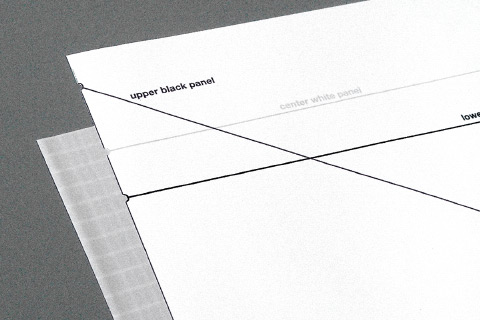
fold icarex sharply, lay the template on top of it and align the left edges of both.
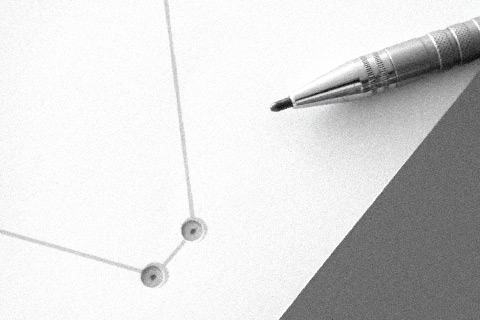
mark all the points through the holes, including the bridle and leading
edge marks for the upper black panel. remove the template, then cut the
still folded panels with a straightedge and a sharp cutter.
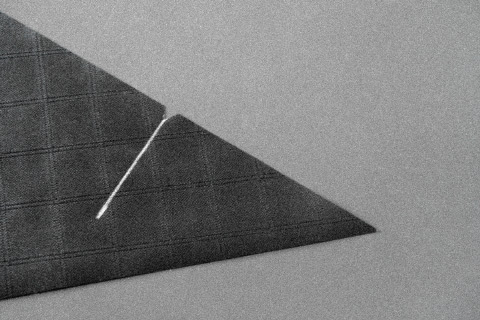
for the leading edge marks of the upper black panel cut a small wedge
as guide for drawing the marks on both left and right sides of the
panel.
here are the measurements for direct drafting onto the sail, again folded first. the units are in mm, millimeters.
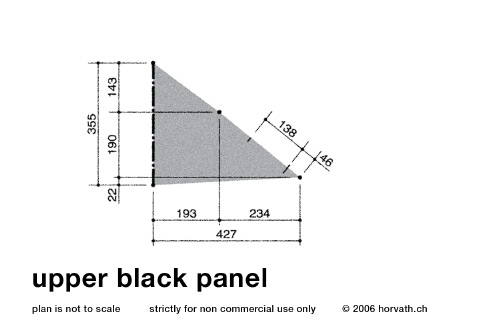



press transfer adhesive tape, 6 mm or 1/4 inch wide, to the back side
of the black panels, leaving a few millimeters free at the center fold.
place one half of the white panel over the highly visible tape liner
and roll it back. remove the liner slowly and let the white icarex drop
back onto theadhesive tape.

lay the left side of the white panel on to its right side, adjust the
position for a good symmetry. remove 1/2 inch of the tape liner at the
center and fold it tightly up at 90°
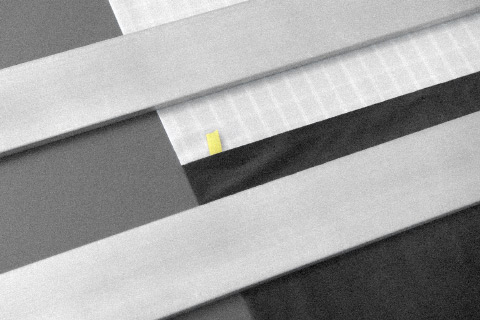
lay the left side of the black panel on to the white panel, adjust the
position accurately and lock it with weights. pull out the liner very
slowly, be careful not to displace the panels. press the black icarex
to the tape with the fingers, do not rub to avoid distortion of the
seam.
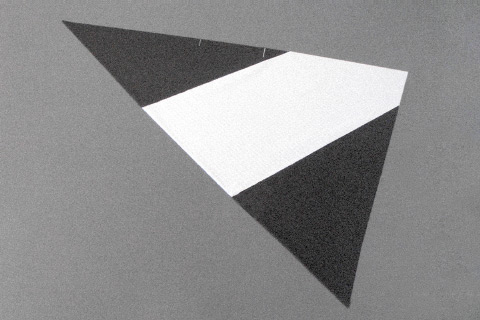
the assembled sail of the kite with the profiled keel: last chance to check for perfect symmetry!
should your finished flying kite lean to one side later in the sky, you
can correct this by moving the y-line along the x-line.

before sewing, make compound patches of an adhesive dacron 12 x 20 mm
and two adhesive icarex pieces 9 x 40 mm. place the compound patches
for the bridle and the z-line attachement exactly at the center fold.
two of them start on the white panel, this will make three layers at
this tension loaded point.
the upper bridle attachment is centered at 110 mm above the end of the
black panel or 104 mm from the end of the white panel. that is 245 mm
from the nose tip. then triple zig zag the panels together, 4 mm wide
and 3 mm long is a nice stitch. at the center you may shorten the
stitches to 1.5 mm to improve resistance.
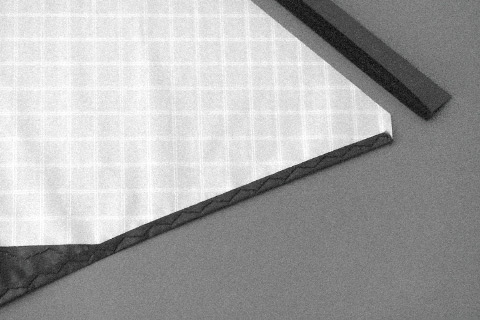
sew first the folded icarex trailing edges, avoid tensions as much as
possible. maybe a long double zig zag, reduced upper and lower thread
tension and a double fabric transport will help. then sew the leading
edges with a narrow medium length triple zig zag.
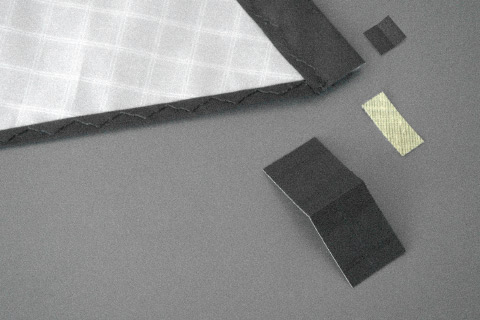
for the wingtip cut pieces of icarex-coated kevlar 6 x 16 mm and
self-adhesive icarex 10 x 10 mm and 16 x 40 mm. stick the small
adhesive icarex patch at the outer end of the leading edge.
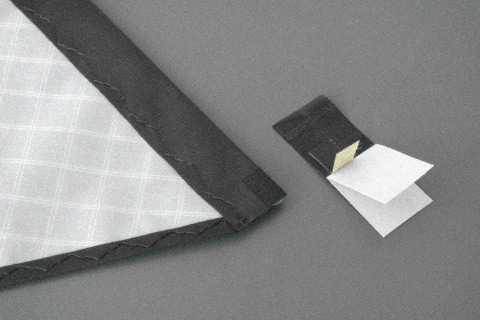
fold the icarex piece sharply, fold the paper liner back and place the kevlar or dacron reinforcement onto the adhesive
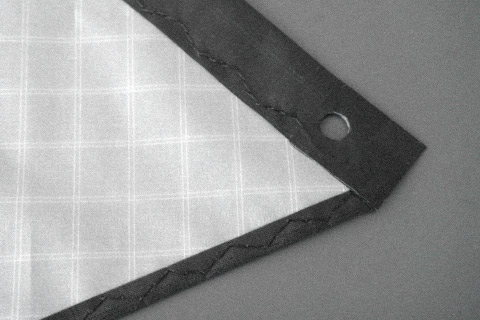
stick half of the icarex piece to the leading edge using the fold as a
positioning guide, turn the sail and press the second half down to the
back side. punch a hole, diameter 5 mm.

place the leading edge spar reinfocement patch. temporarily you may
stick an additional layer here to protect this exposed point of the
leading edge in hard city-flights on asphalt. then cut out the leading
edge: the opening is 9 mm deep and 80 mm long, the lower end at 20 mm,
the upper end at 60 mm from the silver mark.
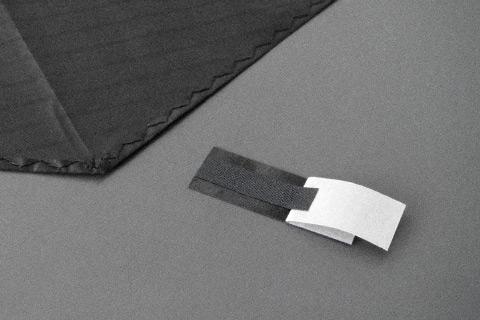
make a compound of adhesive dacron 20 x 50 mm folded at 30 mm and a
piece of dacron 10 x 40 mm for the spine end pocket. stick it accuratly
aligned with the center fold of the kite and sew it to the sail with
two straight stitches.

front side of the spine end: melt the thread ends down and press them to the fabric.

back side of the spine end: punch or melt with a soldering bit two holes, diameter 3mm.
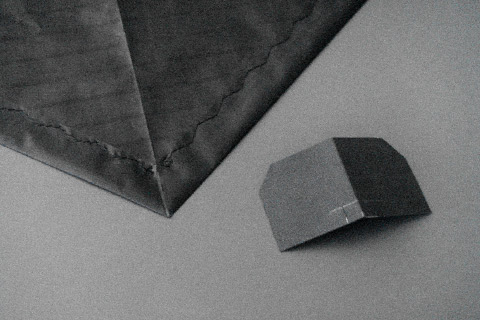
make a piece of adhesive coated dacron 25 x 50 mm with two beveled
corners and two cuts 5 mm long and 5 mm from the center fold.

fold half of the paper liner sharply back and stick the nose piece to
the sail, the sharp folds will help in positioning and centering
accurately.
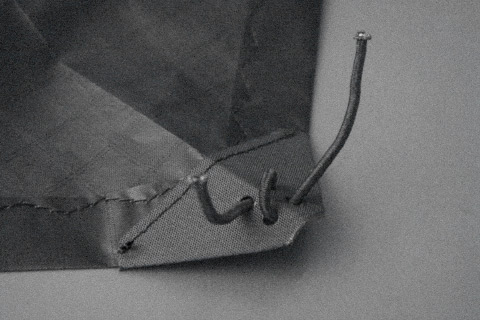
sew the nose to the sail, seal the front tip with a lighter, and punch
3 mm holes. prepare a 85 mm long 1.8 mm bungi cord with good flanges at
both ends.
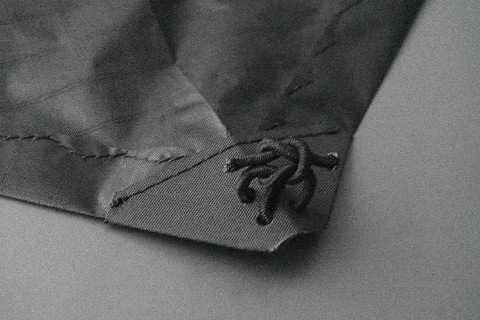
try to make a square knot or reef knot, called the samariter- knoten in
switzerland. use the pliers to arrange it and tighten it with a
continuous pull.
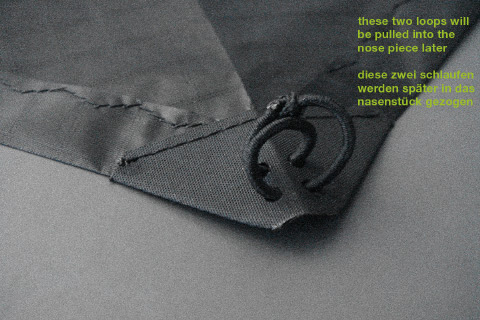
voila! the accurately placed holes and the bungi will hold the spine exactly at the center of the kite.
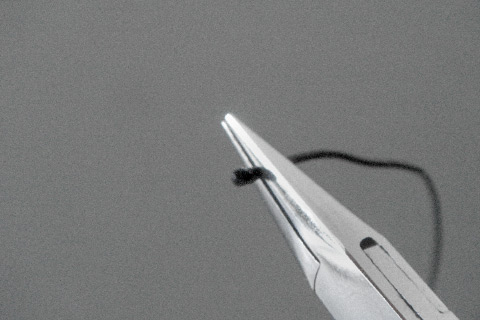
to make a flange: let 4 mm line out of the pliers. all given lengths of
lines include this allowance: the z-line is 130 mm when cut, with the
two flanges melted down it will be 122 mm, ready for the loop.
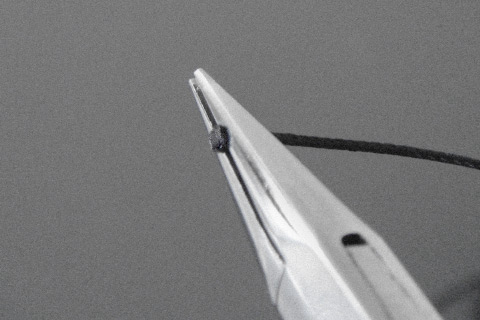
for a nice, compact flange: melt the bridle line and press it even and
gently to the pliers with the plastic part of the lighter.

make a loose loop like this: the line shown is the z-line which will pull down the spine to the spreader.

lay the loop around a slightly conical pen and pull the line until the flange stops at the knot.
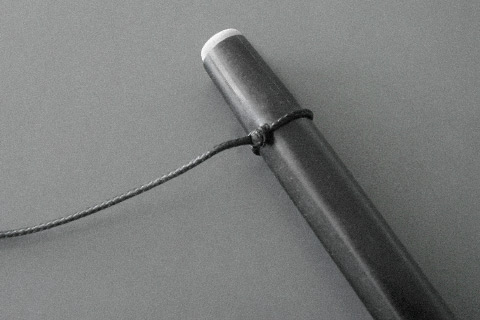
tighten the loop around the pen to proof the strength of the knot.
these loops are made directly on both ends of the x-line, at one end of
the y-line and at one end of the z-line.
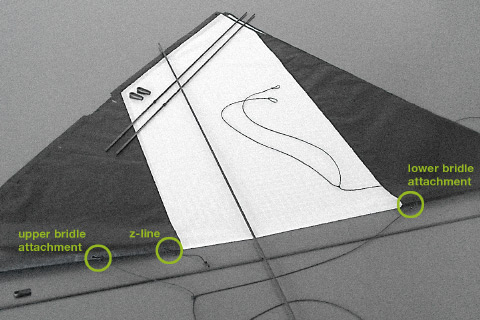
punch or melt with a soldering bit two holes, diameter 3mm, at the
three reinforcements along the spine. we use to fold the sail to make
each pair of the holes in one step, good for symmetry too.
tie the z-line and the two legs of the bridle to the sail and tighten the knots carefully, again with the pen, but leave the loops open for inserting the spine later.
the leader line has an overhand knot, stopped with a flange at each end. larkshead the bridle around a knot of the leader line.
use
the lightest bridle line you can find. we like our all black 320 n
spectra core bridle line, which equals a 70 lb bridle line (such a
sleeved line is 1 mm = 0.04 inch in diameter, and 0.6 mm = 0.02 inch
when pressed in the tighten knot). all lenghts given are for this line,
if you are using heavyer stuff, add a few millimeters at each end. see
more unit conversions at the top of the left column.
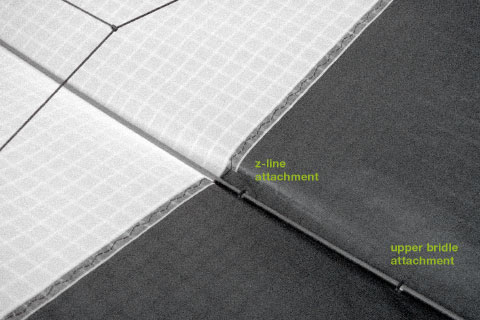
insert the spine through the loops of the z-line and the bridle and
into the tail pocket. shown here the loop of the z-line near the seam
and the upper bridle loop bottom right. tighten the three loops. in the
upper left shown the x-line with the attached y-line, the kite is
assemembled on this photo.
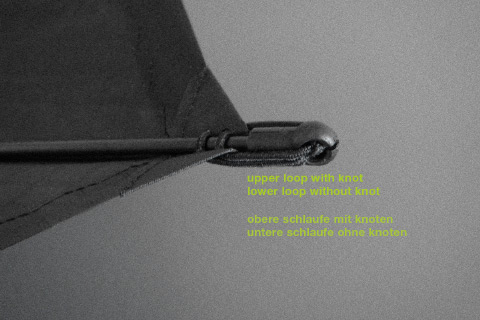
tension the bungi at the nose, putting first the knot into the jaco,
then the second loop. the jaco is cut at the ring and shortened by 12
mm.
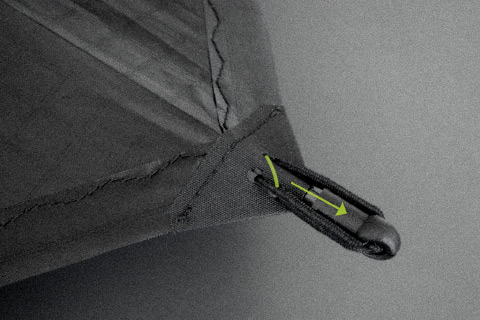
the pic is showing the second diagonal loop of the bungi, which is pulled into the nose piece of the kite.
you may shorten the 995 mm spine a little bit, depending on the
strength of the bungi line and the strain and stretch in the fabric
used. most sail fabric will get longer under tension over time, so let
a couple of mm space between the jaco and the tip of the nose,
especially if the sail is nylon spinaker. but better use icarex.
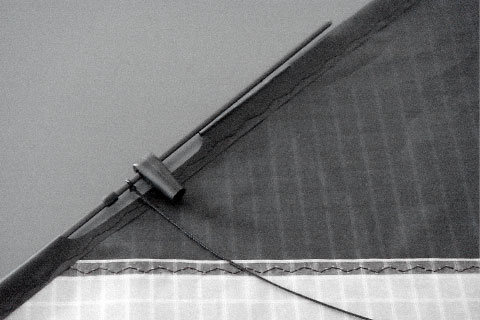
make the upper ends of the leading edge tubes as round and smooth as
possible by sanding them. the backside of the kite is shown. the upper
end of the stopper is 138 mm from the top of the avia.125 3.1 mm carbon
le-tube.

insert the leading edge tubes fitted with the vinyl stoppers from top
through the cutout into the leading edge and through the holes at the
wingtip out again until the upper end is at the cutout. place first the
loop of the x-line above the stopper, then the apa connector . . .

. . . and push the tube up into the leading edge. move the x-line and the apa down to the stopper
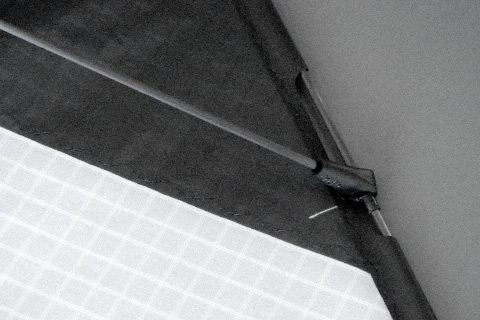
when assembled, the loop of the x-line should align with the silver
mark on the sail. shown here the front side of the kite.
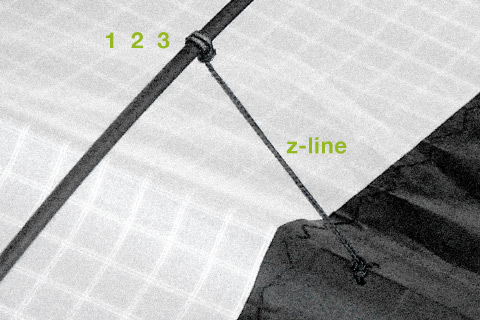
attaching the spreader: extend the loop of the z-line to form a double
loop around the spreader. this is the neutral standard setup for all of
our kites and wings. with a single loop, the z-line will be longer,
with three loops it will pull and bend the spine closer down to the
spreader.
when flying in the city, protect the double loop with a tape or two
small vinyl or teflon tubes around the spreader beside the bridle line.
this will prevent erosion of the z-line loops at take-offs and landings
on asphalt.
now
the kite is ready to beeing built up: bend the spreader by holding both
ends firmly and use the thumbs to place it into the apas. the x-line
will be probably a little bit loose or a little bit tight, this will be
adjusted with the y-line.
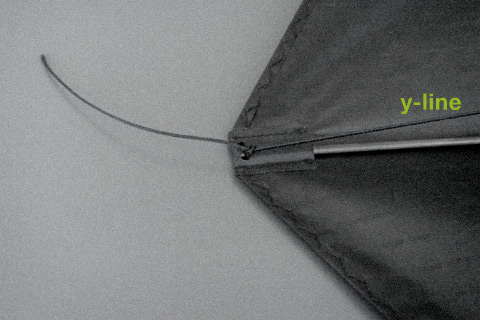
first setup of the y-line: at the tail use two half hitches (zwei halbe
schläge) to tie the y-line around the spine. the x-line line should get
a considerable tension and the sail should be rather slack.
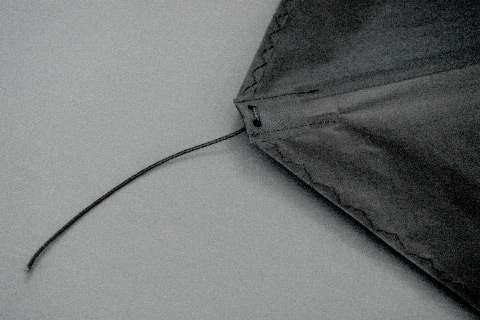
shown here the front side view of the kite, now ready to fly ! ! !
for flights in the city protect the short section of the exposed y-line
with tape, or go with the line through a short vinyl or teflon tube,
which will contact the asphalt at take-offs.



draw the numbers onto both faces, the front side and the back side of
the sail with a black marker pen. stick a sample to the window to test
the effects from an appropriate distance. we use comics-like wide fonts
of course, like this one called "field day filter" and numbers, which
clearly indicate the orientation of the ninja on its wild flights, also
from the back side.
fredi haller, switzerland, is applying highly pigmented acrylic resin
calligraphy ink 29700 from rohrer-klingler for the graphic-design on
his urban ninjas. he's painting with aquarel brushes on either one or
both sides of the sail. after a short drying period the lightfast paint
is resistant to water and abrasion. it doesnt break off when folding
the kite down. the black ink is darker than that of a marker pen and
looks a bit more even.
here's a real scale pdf of this cool font designed by ray larabie. you can print it on a4 sheets. your name is to identify your personal kite on a crowded field, all urban ninjas look the same after all. we would be delighted about a mentioning like "powered by horvath.ch" as well, thanks.
the following pics show the urban ninja with the standard setup: it
will park at 60 m in medium to stronger winds. in zero or very gentle
breezes it has a light, but responsive pull. the short fly aways or
dives will show an extreme nose up tendency, so you will be able to
turn back the kite towards you anytime. the urban ninja rolls backwards
gladly and recovers to a nice short horizontal glide within a few
meters. slacken the line instantly after the impulsive pull to fly this
and most other moves.

the dihedral can be adjusted with the length of the z-line to vary the
yaw stability in glides. as an additional effect of a shorter z-line
the spine bend increases and flatspins become tighter.
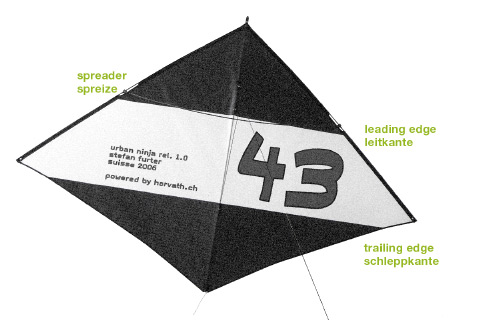

the most important adjustment is the tension of the whole sail. shorten
or lenghten the y-line on the field to adjust the effective span of the
spreader. this affects directly the span of the kite and the slack in
the sail.
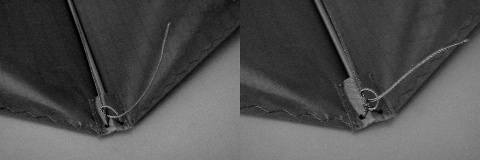
the first half hitch of the y-line at the keel . . . and the second
half hitch. the line goes around the carbon spine as well.
the urban ninja flies best with a very very slack sail, resulting in a
deep billow and an accented keel area. a slack sail slows this fast
little kite down. the airflow will pass a softer, flexible surface,
especially if the icarex is somewhat crinkly, hence adjust the y-line
at will. the pictures show a rather tight sail.
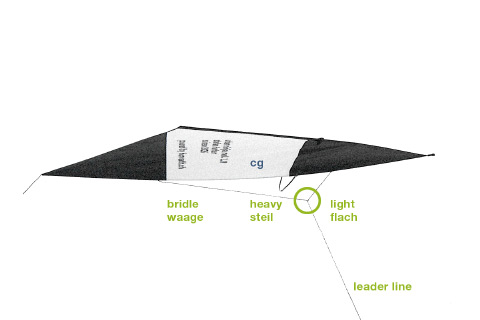
with a lighter bridle setting, the kite will fly more agile and respond
to light, but sharp pulls on the flying line. this is good for the
urban ninja flying style. shown here the aggressive 580 mm bridle, or
600 mm using heavier bridle line.
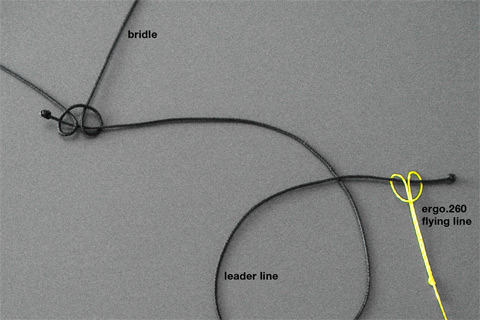
lay 50 m of spectra line (called dyneema in europe) to the ground,
attach it with a larkshead loop to the leader line and fly!
never fly:
the flight card shows the flying style of our kites. the movie of the urban ninja is showing the rather fast freestyle moves. to compare with the single line gliders, here is a movie of a flight with the long way home or a short indoor session with the c'est la vie gran turismo. these clips are in .mov format, on the photos and movies page you find also .wmv encoded clips.
find more information on light materials for kite building, such as measured weights on our kite building page.
thomas k. horvath, zurich switzerland, summer 2006
if you find out any improvement on the kite design itself or some
details or want to help us in correcting our clumsy english in this
tutorial, feel free to send an e-mail to us. thank you!
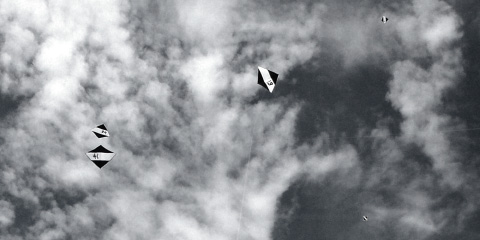
ninjas at the donaueschingen kite festival 2007. there was too little
wind for kites other than synergetic zerowind ones to lift off.
picture © markus egger ch 2007
never ever build your urban ninja kite heavier than indicated in the
specs of this plan, it would be definitely too jumpy and less fun to
control. using icarex, the sound would also be much crisper than with
soft fabrics like chikara, good for locating the kite in the dark. if
it's impossible for you to find the adequate light materials for making
this kite, we can offer:
the
fast and save way to kite building, for kids and teens too: a complete
construction kit with pre cut carbon spars for inexpensive shipping,
the icarex panels are not precut, all materials and parts, including
the non-precut adhesive fabrics to build your own perfect urban ninja.
choose one of our five standard colors for the bright center panel.
without 9460 6-mm-tape, without flying line.
buy now: 48.00 euro
a
complete construction kit for making this kite, with pre cut carbon
spars for inexpensive shipping, the icarex panels are not precut, all
materials and parts, including the non-precut adhesive fabrics to build
your own perfect urban ninja. choose one of our five standard colors
for the bright center panel.
including 6 mm x 55 m 9460 tape (for 26 ninjas or many other kites) and 100 m ergo.260 line on a 105 mm halo-spool.
buy now: 98.00 euro
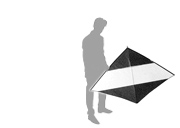 if
you prefer to fly instead of building this single line freestyle kite
you can order a finished urban ninja. choose one of our five standard
colors for the center panel. comes in a black tube, flying lines are
not included.
if
you prefer to fly instead of building this single line freestyle kite
you can order a finished urban ninja. choose one of our five standard
colors for the center panel. comes in a black tube, flying lines are
not included.
buy now: euro 148.00
for further infos on ordering materials for ultralight kite making at our kite-lab please visit our contact and shopping page.
this kite plan is for non commercial use only.
© ch 2006 horvath.ch
![]()
this kite making plan is licensed under a
![]() creative commons attribution-noncommercial-no-derivative-works license.
creative commons attribution-noncommercial-no-derivative-works license.
neu: der komplette deutsche bauplan für diesen drachen!